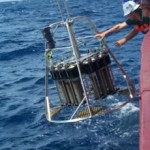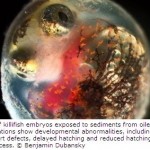The researchers analyzed the spatial distribution of hopane in the northern Gulf of Mexico and found it was most concentrated in a thin patchy layer at the sea floor within 25 miles of the ruptured well, most intensively to its southwest. Peak concentrations of oil were in sediments at depths of approximately 4,000 – 5,000 feet, but as shallow as 3,000 feet and as deep as nearly 6,000 feet.
The researchers say their estimate of the quantity of oil on the seafloor is a minimum figure because they suspect some oiled sediments were not sampled during the research expeditions, including other suspected oily areas around the well, and that some oil certainly was also deposited outside the research zone.
Importantly, the research identified hotspots of oil fallout near communities of damaged deep-sea corals, supporting previously disputed findings that these corals were damaged by the Deepwater Horizon oil spill.
Further, the footprint of oil delivered to the seafloor was about two percent of the footprint for slicks at the surface, showing that oil spread much more widely at the surface than it did in the deep.
The research illuminates several new pieces in the puzzle to assess environmental damage caused by the Deepwater Horizon oil spill and supplies new insights into the behaviour of oil in the ocean.
“Beyond the estimate of how much oil is on the seafloor, this work helps us understand where and how far oil can travel in an oil-gas mixture in the deep ocean, and it helps us figure out where to look for impacts on the seafloor,” says Reddy.
“This analysis provides us with, for the first time, some closure on the question ‘Where did the oil go and how?’, ” said Don Rice, program director in the Division of Ocean Sciences at the National Science Foundation (NSF), which funded the study. “It also alerts us that this knowledge remains largely provisional until we can fully account for the remaining 70 percent.”
Check the following link to read/download the Full Study – “Fallout Plume of Submerged Oil from Deepwater Horizon”:
http://www.pnas.org/content/early/2014/10/23/1414873111.abstract
Source: WHOI.














